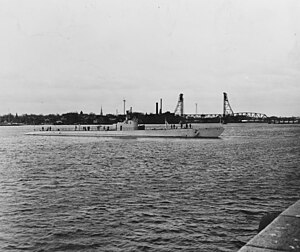General Dynamics Electric Boat (GDEB) is a subsidiary of General Dynamics Corporation. It has been the primary builder of submarines for the United States Navy for more than 100 years. The company's main facilities are a shipyard in Groton, Connecticut, a hull-fabrication and outfitting facility in Quonset Point, Rhode Island, and a design and engineering facility in New London, Connecticut.

The Gato class of submarines were built for the United States Navy and launched in 1941–1943. Named after the lead ship of the class, USS Gato, they were the first mass-production U.S. submarine class of World War II.
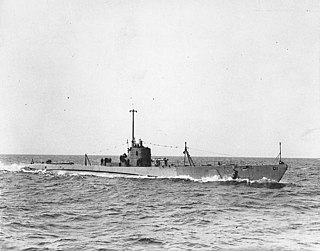
USS Dolphin (SF-10/SC-3/SS-169), a submarine and one of the "V-boats", was the sixth ship of the United States Navy to be named for that aquatic mammal. She also bore the name V-7 and the classifications SF-10 and SC-3 prior to her commissioning. She was launched on 6 March 1932 by the Portsmouth Navy Yard, sponsored by Mrs. E.D. Toland, and commissioned on 1 June 1932.

USS Barracuda (SF-4/SS-163), lead ship of her class and first of the "V-boats," was the second ship of the United States Navy to be named for the barracuda.

USS Argonaut (V-4/SF-7/SM-1/A-1/APS-1/SS-166) was a submarine of the United States Navy, the first boat to carry the name. Argonaut was laid down as V-4 on 1 May 1925 at Portsmouth Navy Yard. She was launched on 10 November 1927, sponsored by Mrs. Philip Mason Sears, the daughter of Rear Admiral William D. MacDougall, and commissioned on 2 April 1928. Although never officially designated as "SS-166", at some point she displayed this number on her conning tower.

USS Nautilus (SF-9/SS-168), a Narwhal-class submarine and one of the "V-boats", was the third ship of the United States Navy to bear the name.

The Balao class was a design of United States Navy submarine used during World War II, and with 120 boats completed, the largest class of submarines in the United States Navy. An improvement on the earlier Gato class, the boats had slight internal differences. The most significant improvement was the use of thicker, higher yield strength steel in the pressure hull skins and frames, which increased their test depth to 400 feet (120 m). Tang actually achieved a depth of 612 ft (187 m) during a test dive, and exceeded that test depth when taking on water in the forward torpedo room while evading a destroyer.

USS Bonita (SF-6/SS-165), a Barracuda-class submarine and one of the "V-boats," was the third ship of the United States Navy to be named for the bonito. Her keel was laid down by the Portsmouth Navy Yard. She was launched on 9 June 1925 as V-3 (SF-6), sponsored by Mrs. L.R. DeSteiguer, wife of Rear Admiral DeSteiguer, and commissioned on 22 May 1926, Lieutenant Commander Charles A. Lockwood, Jr. in command. Like her sisters, Bonita was designed to meet the fleet submarine requirement of 21 knots (39 km/h) surface speed for operating with contemporary battleships.

The Tang-class submarines were the first submarines designed and built by the United States Navy after WWII. They incorporated the best features of the high-speed German Type XXI U-boat and the venerable U.S. Navy fleet submarine. The Tang-class, with the fleet submarines converted under the Greater Underwater Propulsion Power (GUPPY) program, had much higher submerged performance than their predecessors, but were quickly surpassed by the nuclear-propelled submarines that entered service beginning in 1954. Six units in total were built.

The V-boats were a group of nine United States Navy submarines built between World War I and World War II from 1921 to 1934 under authorization as the "fleet boat" program.

USS Bass (SF-5/SS-164), a Barracuda-class submarine and one of the "V-boats", was the first ship of the United States Navy to be named for the bass.

USS Cachalot (SC-4/SS-170), a United States Navy submarine and the lead ship of her class, known as the "V-boats", was the only ship of the United States Navy to be named for the sperm whale. Her keel was laid down by the Portsmouth Navy Yard. She was launched on 19 October 1933 as V-8 (SC-4) sponsored by Miss K. D. Kempff, and commissioned on 1 December 1933 with Lieutenant Commander Merril Comstock in command. Cachalot was the first submarine to have the Torpedo Data Computer, Arma Corporation's Mark 1, installed.

USS Cuttlefish (SC-5/SS-171), a Cachalot-class submarine and one of the "V-boats," was the second ship of the United States Navy to be named for the cuttlefish. Her keel was laid down by Electric Boat Company in Groton, Connecticut. She was launched on 21 November 1933 sponsored by Mrs. B. S. Bullard, and commissioned on 8 June 1934, Lieutenant Commander Charles W. "Gin" Styer in command. Cuttlefish was the first submarine built entirely at Electric Boat's facility in Groton, Connecticut; construction of previous Electric Boat designs had been subcontracted to other shipyards, notably Fore River Shipbuilding of Quincy, Massachusetts. Four Peruvian R-class submarines had previously been finished in Groton, using material from cancelled S-boats salvaged from Fore River.
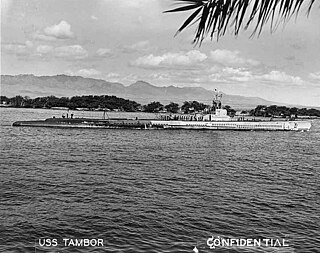
The Tambor-class submarine was a United States Navy submarine design, used primarily during World War II. They were the USN's first fully successful fleet submarine, and began the war close to the fighting. Six of the class were in Hawaiian waters or the Central Pacific on 7 December 1941, with Tautog at Pearl Harbor during the attack. They went on to see hard service; seven of the twelve boats in the class were sunk before the survivors were withdrawn from front-line service in early 1945; this was the highest percentage lost of any US submarine class. Tautog was credited with sinking 26 ships, the largest number of ships sunk by a US submarine in World War II. The Tambors attained the top speed of 21 knots (39 km/h) and range of 11,000 nautical miles (20,000 km) of the preceding Sargo class, and improvements included six bow torpedo tubes, a more reliable full diesel-electric propulsion plant, and improved combat efficiency with key personnel and equipment relocated to the conning tower. In some references, the Tambors are called the "T Class", and SS-206 through SS-211 are sometimes called the "Gar class".

The Sargo-class submarines were among the first United States submarines to be sent into action after the Japanese attack on Pearl Harbor, starting war patrols the day after the attack, having been deployed to the Philippines in late 1941. Similar to the previous Salmon class, they were built between 1937 and 1939. With a top speed of 21 knots, a range of 11,000 nautical miles (20,000 km), and a reliable propulsion plant, along with the Salmons they were an important step in the development of a true fleet submarine. In some references, the Salmons and Sargos are called the "New S Class", 1st and 2nd Groups.
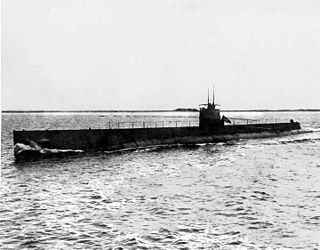
The AA-1 class was a class of three experimental submarines of the United States Navy, built toward the end of World War I, between 1916 and 1919, intended to produce a high-speed fleet submarine. The design was not a success and none of the submarines saw active service. However, the lessons learned were applied to the design of the later V-boats. The class was later renamed as the T class.

The United States Navy Salmon-class submarines were an important developmental step in the design of the "fleet submarine" concept during the 1930s. An incremental improvement over the previous Porpoise class, they were the first US submarine class to achieve 21 knots with a reliable propulsion plant, allowing them to operate with the Standard-type battleships of the surface fleet. Also, their 11,000 nautical miles (20,000 km) unrefueled range would allow them to operate in Japanese home waters. These rugged and dependable boats provided yeoman service during World War II, along with their immediate successors, the similar Sargo class. In some references, the Salmons and Sargos are called the "New S Class", 1st and 2nd Groups.
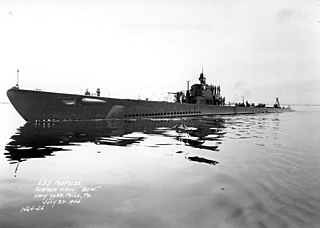
The Porpoise class were submarines built for the United States Navy in the late 1930s, and incorporated a number of modern features that would make them the basis for subsequent Salmon, Sargo, Tambor, Gato, Balao, and Tench classes. In some references, the Porpoises are called the "P" class.

The United States' S-class submarines, often simply called S-boats, were the first class of submarines with a significant number built to United States Navy designs. They made up the bulk of the USN submarine service in the interwar years and could be found in every theater of operations. While not considered "Fleet Submarines" in the traditional sense of that term, they were the first submarines in the USN designed for open ocean, blue water operations. All previous submarines had been intended for harbor or coastal defense. These boats were intended to have greater speed and range than previous classes, with improved habitability and greater armament.

The Mackerel-class submarines were a pair of experimental prototype submarines built just prior to World War II and launched in 1940 and 1941. The two submarines were similar in size and capability to the S-class submarines built at the end of World War I, and had been ordered to test the feasibility of using mass production techniques to build small submarines. Until at least 1940 it was thought that mass production of fleet submarines would be impractical, and in any case small submarines could provide area defense for submarine bases. Once it became apparent that there would be sufficient production of the more capable Gato-class submarines, interest in the design waned and no additional small submarines were ordered. Submarine production standardized during the war on the Gato class and its successors, the Balao and Tench-class submarines. In some references, the Mackerels are called the "M class".
